
SWIM SMARTS

WORLD CUP FEVER


BIKE PARTY







David Gonzalez, a 19-year-old undocumented student remembers the day his mother left for Mexico three years ago and never came back.
After taking a leap of faith to visit Gonzalez’s dying grandfather, his mother was unable to return to the United States because no one in her family held proper documents. She is currently stuck in an extremely dangerous area in Mexico, where there are drug wars, cartels and violence.
“We fear for her life, and we feel that she deserves to be back with her family,” Gonzalez said. “I don’t need her as much as my little 12-year-old brother does. He deserves to grow up under the guidance of my mother.” Gonzalez and his younger brother Manuel are now living in separate homes. They are one of thousands of families torn apart by the deportation of undocumented immigrants. Roughly GO TO PAGE 6
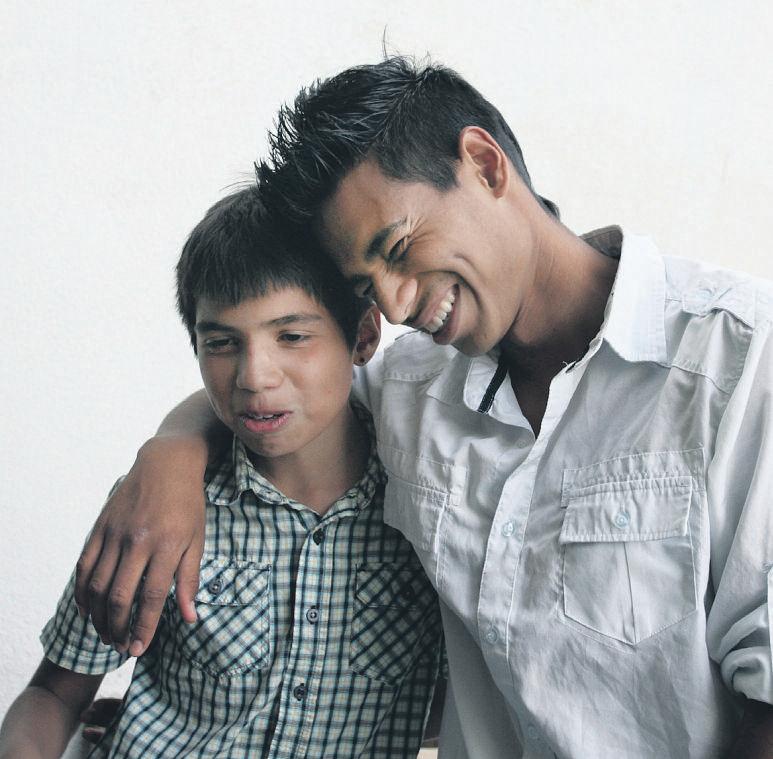
 BY ANTHONY BERON Mosaic Staff Writer
BY ANTHONY BERON Mosaic Staff Writer
For Brianna Mims, using her smartphone to draw up g raphs on Microsoft Excel or navigate her way around online applications is a common challenge that at times prevents the completion of an important amount of her schoolwork.
Mims, an incoming senior at Archbishop Mitty High School in San Jose, does not own a desktop computer.
“Itisde nitelyhardtotypeonmyphonebecausethe keyboard takes up like half of the screen, so trying to write essays and applications are things you can just forget about,” she said. “And when I tried to use Microsoft Excel last year
for AP Biology to make graphs and chart data, I had no idea what to do, because I didn’t have any experience on my own with it and I didn’t know how to practice using the application on my phone or tablet.”
New projects aimed at increasing technological competency have been implemented in parts of Silicon Valley and are now mirrored by other local efforts in the San Francisco Bay Area to diminish this “digital divide.” However, for a growing number of those like Mims, their computer problems stem from not being able to get ready access to proper equipmentthatwouldallowthemtomorepro cientlyuse word processing programs and other important software.
With growing numbers of affordable cellular devices
San Jose debates regulating marijuana
BY JACINTA CHANG Mosaic Staff
available for lower-income consumers, nearly 90 percent of Americans have a cell phone, but 20 percent do not own any other kind of computer, according to a 2014 Pew Research poll.
Oakland Technological Exchange West, which was started by former IBM employee Bruce Buckelew in West Oakland, sells refurbished computers for $100 to people after they attend a free, three-hour course on how to use word processing programs and the Internet.
TamPhamchaperones rst-gradersfromSanJosetothe Tech Museum of Innovation each Friday of the month to
Audrie’s law would outlaw cyber-bullying, raises concerns
BY ENYA KUO Mosaic Staff WriterThe California Legislature is working on a proposed sexual assault and cyberbullying law inspired by the case of Saratoga High School student Audrie Pott, who committed suicide in 2012 after she was sexually assaulted at a party and photographs of the assault were distributed to classmates.
“Audrie’s Law” would include unconscious and developmentally disabled victims in California’s de nitionofforciblerape,man-
date rehabilitative sex offender treatment for juveniles convicted of sexual assault, and allow open courtrooms in such cases.
It would also make cyberbullying, using electronic technology and communication such as cell-
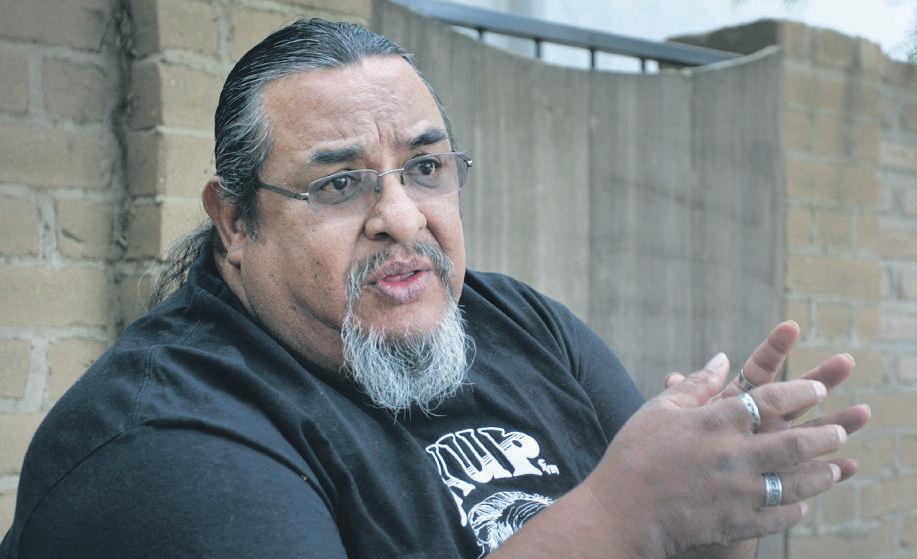 BY TONJANAE WATSON Mosaic Staff Writer
BY TONJANAE WATSON Mosaic Staff Writer
Few people receiving a fatal prognosis publicly announce they will soon die; even fewer deal calmly with death approaching. But Jose Montes de Oca of San Jose is a rare person. On June 18, Montes de Oca posted on Facebook that he has three to six months to live because of his liver cancer.
But before “life happens,” this social activist will remain busy. He hopes to create a program to support at-risk teens, visit favorite wineries, and see the Grand Canyon. Meanwhile, Montes de Oca’s nonchalant announcement, two days before turning 61, brought an unexpected response. As surprised and saddened


Anthony Beron Fifteen-year-old
journalist Anthony Beron enjoys taking public transportation, which he likens to“ oatingdownariver”with other people, or extremely slow teleportation. Since his family has forgone Internet access in the home, Anthony spends his free timereading ction(favoritebooks include “Fahrenheit 451” and “All the King’s Men”) and his favorite newspaper, the New York Times. On weekends, he enjoys sailing on San Francisco Bay. Anthony admires the East Coast for its “edgy” feel After college, he aspires to live in New York. He lives in Oakland with his parents, younger sister and pit bull mix named Dino.
Carl Sibley

Bahaar Muhar Bahaar Muhar is a rising senior at Lincoln High School in San Jose. Born in Phoenix, Ariz., Bahaar moved to India when she was 11 months old, then moved to San Jose as a 3-year-old. At her school, she is active as theater stage manager, editor-in-chief at the campus newspaper, president and founder of the journalism and Make-aWish clubs and captain of the badminton team. Outside of school, she participates in Bhangra Indian dance and volunteers for the American Cancer Society. Bahaar lives with her parents, two foreign exchange students whom she looks to as older siblings, and her three younger siblings.
Luisa Simpao

Calyse Tobias Calyse Tobias, a rising high school senior at West Valley Community College’s Senior Advantage program in Saratoga, is a member of the Mosaic photojournalist staff. She inherited her passion for photography from her father’s childhood love for cameras. Calyse started shooting with her Canon D200 in the seventh grade. She and a friend started a web magazine in 2012 and reviewed and photographed the local music scene. Calyse is also a writer, is opinionated and can talk for hours about feminism and society. The well-rounded Calyse plans to attend UC-Santa Cruz and hopes to work at National Geographic.
Iris Hung
friends and family call, the man who says he has a religious experience every day said,“I ndmyselfconsolingthem.”
This inspirational man was born in Dos Palos in the Central Valley. He learned about social activism from his mother, who helped farmworkers. After g raduating from San Jose State in 1975 with a B.A. in sociology, he worked for 28 years at the Alum Rock Counseling Center. Soon he will be ready to launch the Compadre Project to recruit and train mentors for high-risk Latino youth. Like the 100 Black Men organization, Compadres will “teach them what it is to be a straight-up person, so that they can be successful.” Montes de Oca’s involvement in the community and his work have made a

Car l Sibley Carl Sibley, 16, of Mountain View, is an upcoming junior at Bellarmine College Prep. He writes for the school newspaper, The Cardinal, and belongs to the school journalism club. He sees journalism as “a marriage between exploring and writing.” He lives with his parents, a younger sister and three pet hermit crabs, each of whom he loves very much. Carl describes himself as creative, calm, pensive and rational traits that resonate in his mellow voice. His favorite class is English, best read was the fth Harry Potter book, and favorite movie is the modern remake of “The Pink Panther.”
Anthony Beron

Cohen Price
When “Careful
Cohen” Price steps into the room, it’s to the chorus of Beyonce’s “Single Ladies.” A track star at Eastside College Prep in East Palo Alto, Cohen is fourth in his league for the triple jump, but it is his passion for writing that brought him to Mosaic.The rstnight,afteranintense game of ping pong, which neither of us could play with any ounce of skill, we agreed that by the end of Mosaic program we would be either great journalists or great ping pong players.
Nathaniel Dalerio

Enya Kuo
Enya Kuo, 17, loves tea brewing and inDesign and is a rising senior at Irvington High School in Fremont. Born in Taiwan, the passionate young writer moved to the Bay Area with her family nine years ago. Since junior high, Enya has immersed herself in journalism and will be an editor-in-chief of her school newspaper. She is a classically trained pianist, but plays ragtime at festivals and concerts. She loves Italian and Taiwanese food, reading, traveling and following the blog “Humans of New York.” She dreams of living in a small but organized apartment in New York City.
Talia Moore

Haley Kim Born and reared in San Jose, Haley Kim does not like doughnuts, loves nail polish, and enjoys shopping at Anthropologie. Haley, 17, attends a San Jose charter school called Summit Public Schools: Rainier. Haley has a passion for arranging words on a page and delving into fantasyandrealistic ction,aswell as fashion design. She is a sweet girl who you probably should not mess with. In just four years, Haley has received a gold and two silver medals in Kuk Sool Won martial arts competitions. She likes to be
huge impact. His college friend, Peter Ellis, said he dedicated his life to people and their families. “In some ways he was the founder of Alum Rock Counseling.”
Montes de Oca is also straightforward. Answering his doctor’s call, he said, “No news is bad news. Give it to me straight.” The doctor said that the cancer had returned to his liver and entered his bloodstream. Rather than feeling depressed, Montes de Oca posted the news on Facebook; it brought a great return. The news spread from network to network, and long-lost cousins have gotten in touch. He said, “It’s just bringing my family together again in ways that I didn’t anticipate.” His calm is rooted in his faith. “He’s a g odly man,” said his girlfriend, Lupe
challenged, but also is a procrastinator and likes comfortable sweats.
Tonjanae Watson

Iris Hung Iris Hung, 16, is an incoming senior at Mills High School in San Mateo. She has cultivated her artistic talent in drawing from a young age. She bought her rst digital camera in sixth grade, and took journalism in her junior year. Iris enjoys photographing sports and clubs and writing sports features. She prefers photography over writing because photographs portray more accurately what interests her in the world. Iris’ dream photojournalism assignment would be to shoot such sports teams as the San Francisco Giants, San Jose Sharks, or FC Barcelona. She hopes to work for the Associated Press.
Calyse Tobias

Jacinta Chang Holding a milk tea in one hand while I nstagramming artsy photos in the other, Jacinta Chang might seem like your typical 16 year-old rising junior. But look closer, and you’ll see that she has a passion for every aspect of life, whether it is planning events, trying new recipes, or keeping sports scores. In addition to being a chapter and regional ofcerforthestudentbusinessclub DECA Jacinta will be the Web editor for the Mission San Jose school newspaper and scriptwriter for its TV station. Jacinta hopes to voice her opinion through writing and photography in the Mosaic program and beyond.
Kelly Song

K elly Song A writer for a Redwood Shores community paper, Kelly Song strives to ndastoryin every aspect of life. The rising junior at Carlmont High School dreams of pursuing a career in journalism. She also loves playing the violin and plays in the San Francisco Conservatory of Music.Shefoundedanon-pro t foundation to raise money to build a school in Kenya. Adventurous and daring, Kelly enjoys anything that will give her a thrill: ziplining, parasailing, and riding roller coasters, to name a few. Through Mosaic Kelly hopes to achieve what every journalist wants: the ability to tell a good story about anything and everything.
Jacinta Chang

Luisa Simpao Luisa Simpao, who moved from the Philippines at age 10, will be a senior at Mills High School this fall. She has participated in the school’s journalism class since 10th grade; this year she will serve as editor-in-chief. Besides journalism, Luisa partici-
pates in swimming, cultural clubs and advanced placement classes. She will be a youth ambassador to Japan later this summer. In Mosaic she wants to learn new skills and tactics to apply to her journalism class and school newspaper. Luisa also enjoys Broadway music, blogging and graphic designing, and hopes to attend Boston University.
Bahaar Muhar
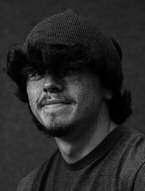
Nathaniel Dalerio Competing in the wrestling match that would determine his progression in CCS, Nathaniel Dalerio, down by two points, needed to to tie the match to head into overtime. He gave it hisallandbeganthedif cultmaneuver, but time ran out. While Nate was disappointed, he accepted the result and felt that, “It was a reminder that every second counts.” Nate, part of the Alisal High School wrestling team, began wrestling because of his family. He comes from a line of male wrestlers, from both sides of the family. He has been wrestling since the seventh grade. But he has been writingsincethe fthgrade.Nate enjoys writing poetry. It’s something to take the edge off life.
Cohen Price

Talia Moore
Concussions and crutches never stopped Talia Moore from doing what she loves. The San Francisco native, an incoming senior at George Washington High, has played soccer since she was 4. Her most recent injury, a concussion from heading a ball, hasn’t diminished her passion for the game. Off the eld, Talia writes songs and sings in her school’s Chamber Choir. Talia is passionate about breaking down social stereotypes and ghtingforequalopportunity. Her favorite subject is English, and she is the editor-in-chief of her school’s news Website. In her downtime, Talia might be listening to indie and R&B music, sketching or sipping Earl Grey.
Enya Kuo
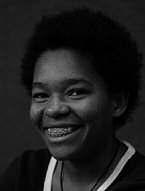
Tonjanae
Watson Tonjanae Watson, 17, could be Disney’s Princess Tiana or Cinderella, because both are nice, generous people like her. An upcoming senior at Archbishop Mitty in San Jose, her favorite subjects are electives. Though she doesn’t read music, Tonjanae plays the piano, and her favorite song is “Titanium.” She wants to be a screen actress, has done a commercial and was an extra in “I’m in Love with a Church Girl.” If she were a pair of shoes, she would be Jeremy Scotts, because “they stand out in a crowd and are not like ever yone else.”
Haley
KimLujan. Montes de Oca said that dedicating his life to God every day allows him to have no fear and live his life to the fullest.
“I really do believe and have faith that when I’m gone I’m going to be in a better place,” he said. “But that doesn’t mean that I’m just going to lay down and die.I’mgoingto ght.I’ma ghter.But when it’s all said and done, I win.”
He’s planning his bucket list, consideringsuchactivitiesasmarlin shing in Cabo San Lucas and revisiting New Mexico. He’s asking for prayers. “I’m asking for a miracle to happen to my liver and my blood, and I’m asking for an opportunity to serve, that’s it.”
MOSAIC PROFESSIONAL STAFF
Executive Director
Marcos Cabrera
Director Emeritus
Joe Rodriguez
Managing Editors
Sharon Noguchi
Robert Salonga
Photo Editors
Nhat Meyer
Karl Mondon
Design Director
Julie Reynolds
Copy Editors
Chuck Carroll
Patty Hannon
Editoral Assistants
Mariana Barrera
Gianna Dimick
Guest Advisers
Elliott Almond
David Early
Sean Webby
Web Designer
Kimberly Chua
BAY AREA NEWS GROUP
Publisher
Sharon Ryan
Executive Editor
David J. Butler
Managing Editor
Bert Robinson
Pressroom Manager
Stan McCallum
THE MONTEREY COUNTY HERALD
Publisher Gary Omernick
Executive Editor
Don Miller
Managing Editor
David Kellogg
SJSU
Director of Journalism
Robert Rucker
Production Manager
Tim Burke
University Housing
Rachel Delucci
SPONSORS
San Jose Mercury News
Joe Parisi/Thermacorp
Bay Area News Group
San Jose State University
Monterey Herald
Dow Jones News Fund
CCNMA Latino Journalists of California
Castellano Family Foundation
The Martin Family
Police arrested 10 “Occupy Google” activists pushing to preserve Internet equality
at Google headquarters in Mountain View on June 24 after they refused to leave for the night.
Fueled by vegan pizza, poppy-seed granola bars and organic strawberries, about 20 activists gathered earlier that day in front of the Googleplex to urge the Internet giant to take a stronger stance supporting “net neutrality,” which until recently was the prevailing practice by telecommunication companies to transmit all online content equally.
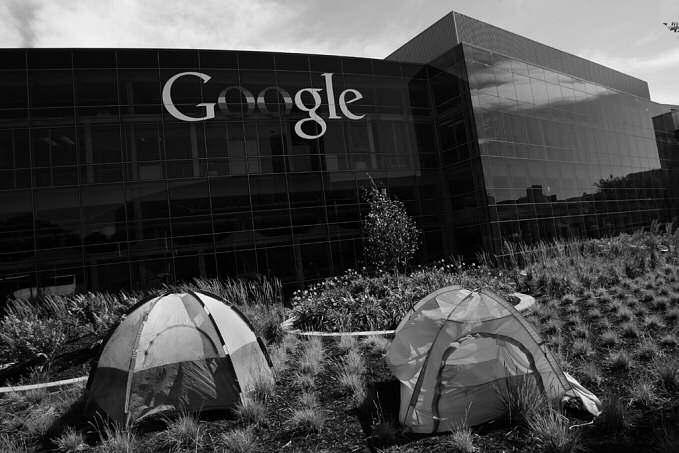
The 11 p.m. arrests boosted local media attention on the issue, with news outlets and social media covering the day’s events.
Demonstrators called on Google to show support by blacking out its
Maki O’Bryan faced the teacher from hell her junior year at George Washington High School in San Francisco. The teacher was constantly late to class, talked about her personal life, put down her students and the school and gave bad grades to those who even questioned her.
“If she didn’t have tenure I don’t think she would even work here,” said O’Bryan. So O Br yan, a rising senior, wishes California law would not protect ineffective teachers like her dreaded AP English teacher.
Students like O’Bryan just might get their wish.
In a lawsuit known as Vergara vs. California, a Superior Court judge this month dismissed ve laws on teacher employment. As aresult, California may soon revise how its public school teachers are granted tenure, laid off and dismissed. Judge Rolf Treu ruled that teacher tenure laws violate students’ rights to an equal education and harm in particular minority and low-income families.
In revising those rules, a key element will be how schools evaluate teachers. Should students’ and parents’ opinion count? Some students say that even when ateacher with poor skills or abad attitude makes it dif cult to learn students can’t do anything about it.
Christopher Leong-Sanchez, a rising senior at James Lick High School in San Jose, had to put up with a teacher who did little but give worksheets all year. “I went to the vice principal about it. She said she couldn’t really do anything about it, I had to deal with it.”
Dana Dela Cruz, of Mills High School in Millbrae, also believes schools usually don’t listen to students -- although once, during her freshman year, students who complained about a frequently absent teacher who gave confusing assignments g ot the administration to help improve the teacher’s behavior.
“Studentevaluationsshouldde nitelyhaveconsequences,butthatdoesn’t necessarily mean bad teachers should be red; teacher training and workshops can also be an option,” Dela Cruz,15, wrote.
Sometimes, parent opinion does matter. At Alamo Elementary in San Francisco,parentscomplainedinDecember2012abouta rst-gradeteacher’smultiple absences. At the end of the school year, the teacher transferred to another school — satisfying Alamo parents, but possibly creating problems elsewhere.
“The current system isn’t working to ensure that every classroom has a quality teacher,” said Joe Speaks, one of the parents who complained to the board of education.
Someteachersfearstudentevaluationswouldbene tpopularteachersand not necessarily competent ones.
logo and hosting links to online petitions, similar to its actions in 2012 when opposing feared censorship posed by the Stop Online Piracy Act. SOPA called for the total reduction of digital copyright infringement.
“Google is pro-net neutrality, and they have the power and the resources to actually make a huge game change in this short window of time,” said Rebecca Towne, a 23-year-old East Bay activist.
The demonstration’s origins date back to January when the U.S. District Court of Appeals in Washington, D.C., overturned the Federal Communications Commission’s “open internet order,” allowing Internet service providers such as AT&T, Comcast, and Verizon to determine connectivity speeds based on how much a Web content provider pays Critics say allowing this to stand would lead to Web censorship and open doors for powerful Internet companies to dominate smaller ones.
The demonstrators pitched tents in front oftheGooglebuildingandhandedout i-
ers. Google intern Carlos Guillen, 19, took a ier,butsaidthedemonstrationwasmisdirected because Google employees are already aware of the net neutrality issue.
“But there’s a lot of people out there who don’t even know about this. So it seems like they’re targeting the wrong group,” said Guillen.
Protesters did not say how long they would be demonstrating at Google.
“We planned to arrive, and that was about as far as our plans went,” said an activist who went by the alias “Tom James.”
“Google is the tertiary goal,” he added. “The primary goal is to get people really talking about net neutrality.”
Oakland resident Alex Forester wore rainbow-colored pants as she strummed a guitar and improvised songs that called for Google to take direct action.
“Google has such an audience and so many things that they can do,” she said. “So I think they have a social responsibility and we need to make them accountable.”
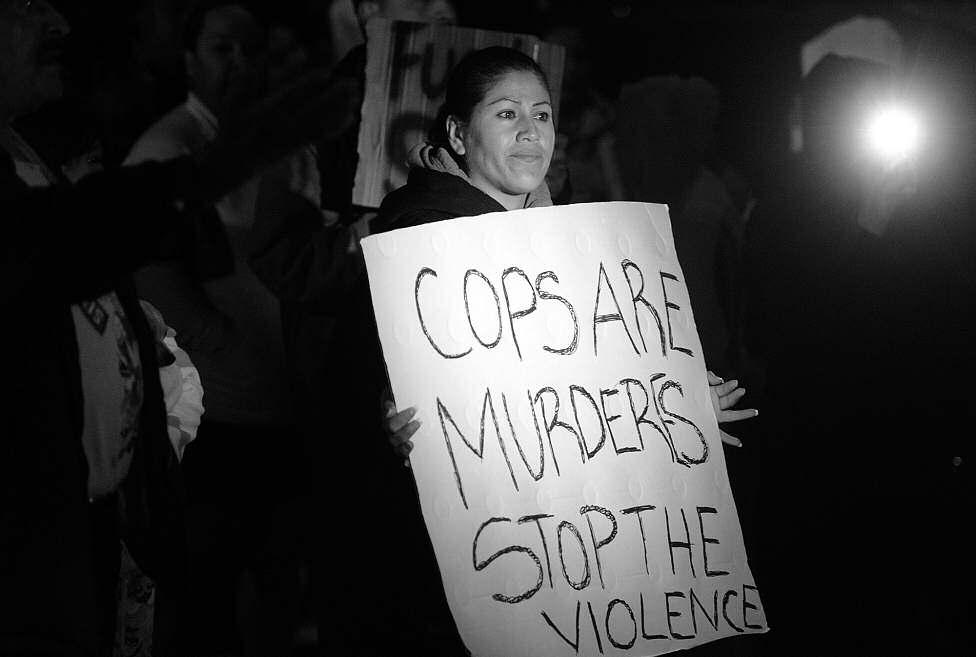 BY NATHANIEL DALERIO Mosaic Staff Writer
BY NATHANIEL DALERIO Mosaic Staff Writer
Threeof cer-involvedfatalshootings have riddled the city of Salinas since March, an unusually high number for a city that averages one police shooting per year, putting the public up in arms against those sworn to protect them.
These incidents have raised varied perceptions of law enforcement, and questions aboutof certrainingforsituationswhere the public is in danger.
suspects and shooting guns out of suspect’s hands. There is no such thing as “shooting to wound” in the police department, he said.
Social media, such as the YouTube video of the shooting of Mejia, is also having a growing effect on the perceptions of the police department and how members of the communityjudgeanof cer’suseofforce.
“It can be a great tool but it has its drawbacks,” says Critchley, “On the one side, it allows us to be more involved with the community and improve understanding as well as receive and provide feedback much more quickly otherwise. On the other hand, we haveno lterforthefalseinformationothers can post.”

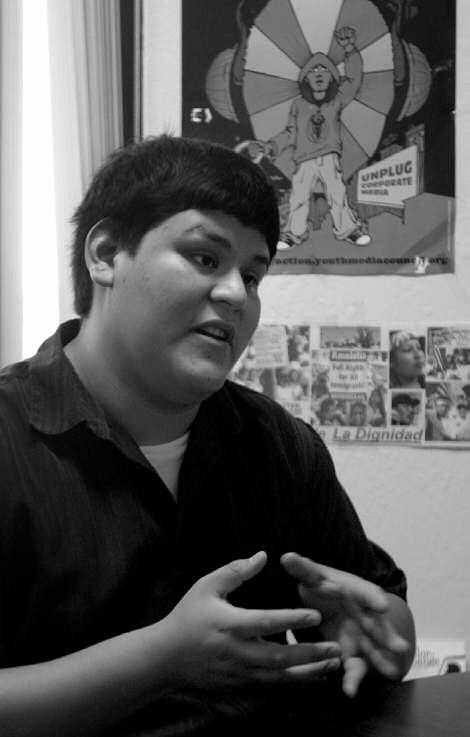
But Ryan Nordvik, who solicited students’ reviews each semester when he taught physics at International Studies Academy in San Francisco, said he values their judgment. He said a good solution would be to have anonymous evaluations by students, or to consider a student’s feedback for all of his or her teachers.
Not everyone agrees. Primary among critics, teacher unions oppose having performance evaluations count in teacher dismissal and layoff decisions.
Both the California Teachers Association and California Federation of Teachers plan to appeal Vergara. Frank Wells of the CTA said student evaluation is problematic. “Actual evaluation should be done by people who have been trained to do it,” said Wells.
Royce Branning, a recent g raduate of Menlo-Atherton High School agreed. “I don’t think many students, myself included, are capable of objectively evaluating how good a teacher is at their job,” he said. “Different teaching styles appeal to different students, and the grade a student receives can alter his or her perception of the class and teacher.”
But some charter schools, which are independently operated from elected school boards and mostly employ non-union teachers, consider student opinions in reviewing teachers. Among them is Summit Public School: Shasta, in Daly City. “Generally, I think that kids are good at knowing when they are learning and when they’re not learning,” Summit math teacher Zack Miller said. Even though students may not always say the right things for the right reason, Miller said, his experience with student surveys has always been good and his colleagues seem to think it’s fair. Perhaps the public school system may follow Summit’s lead.
Leong-Sanchez of James Lick said an evaluation only by administrators isn’t going to do a school justice. “You need to hear it from the victims, from the students themselves because they are the ones being taught by the teacher.”
The most recent shooting, of Carlos Mejia, 44, occurred May 20 and a video of the shooting went viral soon after, sparking a protest that ended in a clash between police and protesters.
The demonstration turned violent after the mysterious shooting of a bystander, Constantino Garcia, 23. The young father wasgivenCPRbyanof cerwhowasthen injured by a bottle thrown from the crowd. Garcia was rushed to a local hospital where he died from his injuries.
Some were upset by the three of cer shootings because they involved Latino victims, sparking accusations of discrimination Police responded with statistics in a statement released before the protest: “In Salinas, 77 percent of the population is Latino 8 out of 10 of the small number of people who commit violent crimes would probably be Latino.”
Criticsofthepoliceshootingssaidofcers acted too rashly, and put themselves in unnecessary danger that led to deadly force. Oakland civil rights attorney John Burris, who is representing Mejia, said at a press conference that “under the Constitution and under the state law of California, a police of cer cannot put himself in har m’s way through negligent conduct, and then shoot himself out of it, and then expect the Constitution and the laws to protect him.”
Spencer Critchley, the Salinas Police Department’spublicinformationof cer,said when a suspect becomes an imminent threat to the public, second guessing isn’t a privilegeallottedtopoliceof cers.
“Police don’t shoot to punish people,” Critchleysaid.“Everyof cerwouldagree that no one deserves to be shot without trial, but when their life is in danger, or the lives of the community are in danger, they aren’t trained to wound, they’re trained to stop the threat.”
Critchley said that a lot misconceptions are rooted in media and that in TV and movies, people see of cers tackling ar med
The Salinas Police Department’s policy manual states deadly force is “force reasonably anticipated and intended to create a substantial likelihood of causing death or very serious injury.” Also according the manual, deadly force is the last resort for anypoliceof cerusedonlywhenallother avenues for subduing the suspect, such as Tasers and pepper spray, have failed.
“Tasers can have mechanical failures and OC(pepper)spraycanmiss,”Of cerDave Shaw said.
Shaw said in his 26 years of duty, there have been a number of occasions when he’s had to draw his rearm only to holster it when suspects complied.
“The suspect has the most control of the situation; it’s how he chooses to use that control that dictates the outcome,” he said.
At the beginning of their careers, police of cers go through six months of police academy where they are trained on how to respond to different situations. Overreaction, as well as underreaction, can result in dismissal.
Of cersthenundergo eldtraining through the department. After that has been completed, they train continually. To do this, Salinas police offer Advanced Of cer Training, a biannual mandatory eight-week program, Shaw said.
Of cers learn new skills as well as review old ones. Lessons include process of law, ofcersafety,driverstraining,andtheuseof force, both lethal and nonlethal.
These programs are taught in-house at theSalinasPoliceDepartment.Of cers undergocerti cationtrainingtothencome back and teach other members of the department.
“The training and preparation never stops, everyone from the chief down participates in these programs,” Shaw said.


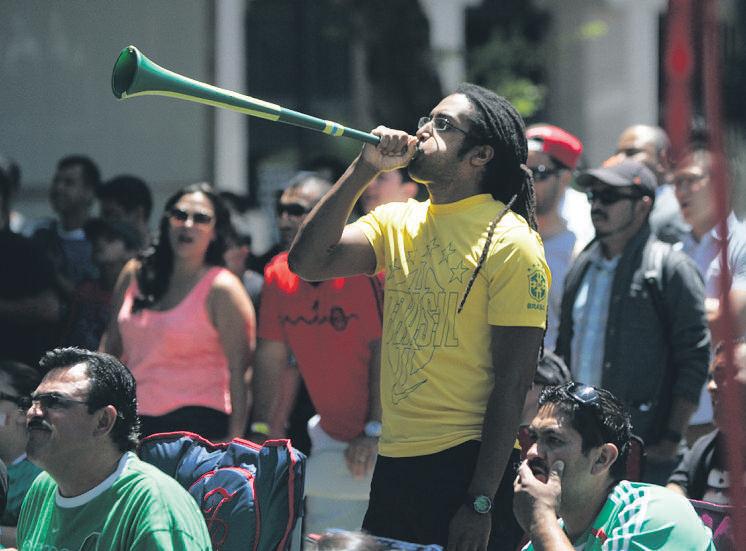
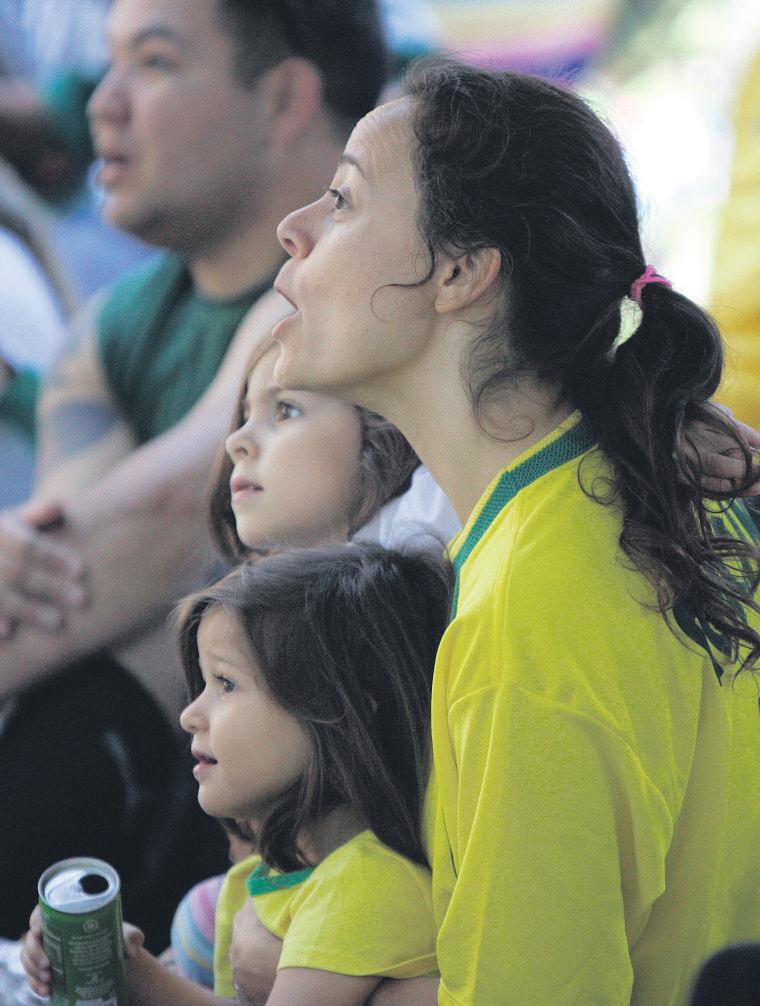

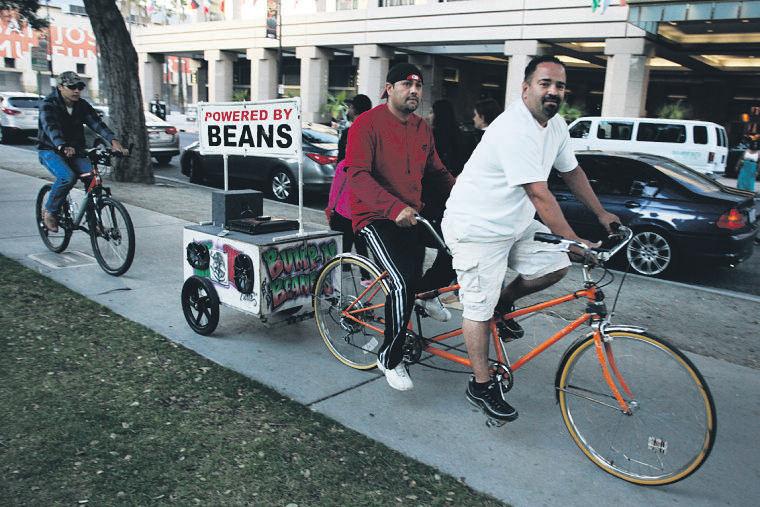


ment, called the loss devastating.
YettheRep’songoing nancialand ar istic woes had prepared some fans for its June 11 closing. Steve Hartman of San Jose, a patron of the Rep for more than 25 years, said that the Rep wasn’t very well managed. Hartman said the theater has been emptier in recent years. “The best evidence of this is the dominating majorty of white and bald heads in the audience,” he wrote in an email. Theater companies must balance business with artistry, said longtime season t cket ho der Larry Stone. Often, though, “The creative side begins to dominate business,” said Stone, who is the Santa Clara County assessor, and said this may have happened at the Rep. “They went a little sideways in trying to do more provocative things than the community was ready for.”
Hartman wrote in an email, “the few attempts at ‘topical’ play themes didn’t attractnewtheatergoersandseemeddifcult to relate to for older subscribers.” He named shows that centered around current topics,
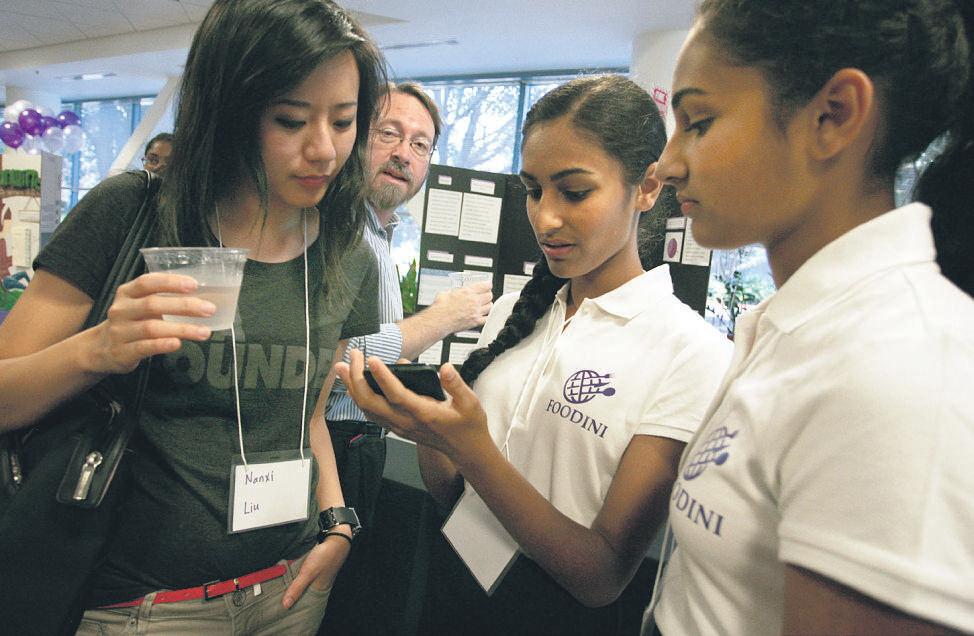 BY COHEN PRICE Mosaic Staff Writer
BY COHEN PRICE Mosaic Staff Writer
Throat itches, tongue gets sticky, throat nar rows breathing turns to gasping. These are the annoying and sometimes fatal reactions that can happen to people with food allergies who eat the wrong food. Of course, they don’t usually intend to eat the wrong thing; it tends to happen by accident sometimes when traveling abroad and information is mistranslated.
Some may ask, how to resolve such a problem? Anjali Walia, Anushka Walia, Jessica Singh and Sriya Lingampalli, all rising sophomores at Irvington High School in Fremont, have come up with an answer.
The girls formed a group called the Fantastic Four, which developed a mobile app to translate dietary needs into four languages. The idea was inspired by twins Anjali and Anushka Walia, who share an allergy to g arbanzo beans and peanuts, which landed them in the emergency room multiple times.
Theteam nishedsecondJune18inthe Technovation Challenge in Santa Clara, an international competition designed to devel-
op more engineering skills in young women. The event s a technology entrepreneurship program that trains young women to develop mobile apps, then present them in a competition. This year the challenge drew 842 teams from 19 countries around the world. It was sponsored by Iridescent, a Mountain View-basednonpro torganization. TheFantasticFourwerevyingfor rst pr ze of $10,000 and planned to donate their winnings to organizations that research food allergies.
“I thought they did really great; all teams were really great,” said Vaishali Walia, the Walia twins’ mother. “They are extremely happy with second place, they never expected to get this far.”
However rstplacewenttoagroupcalled “Health in a Drop,” and their app ApaPura, which gives users a map of the quality of local wells and provides suggestions for water treatment options.
Vaisha Walia has experienced terrifying moments after her daughters ate the wrong food. She explained how an itchiness starts around the girls throats, which gradually spreads around their body in hives. Their
throats start to close up, which threatens the r breathing.
In order to relieve symptoms, the girls need to inject themselves with an Epipen, a portable dose of epinephrine that improves breathing and reduces wheezing and swelling. However, the effects of the Epipen last only for a while, until patients can get emergency medical care and doctors ensure that ever yth ng s OK.
“It’s really nerve-wracking,” Vaishali Walia said about the heart-dropping situations.
The Fantastic Four plan to continue production of their app — which they had named Foodini but will rename — and soon hope to make it accessible for free to anyone in need of it.
Using some of the programming skills that they learned at Technovation, they will addatleast vemorelanguagestotheapp.
They also plan to add other features, such as allowing the app to send users an email of all the r dietary restrictions.
“We want to make sure that everyone has the freedom to live their life the way they want to,” Anushka Walia said.
By ENYA KUO and LUISA SIMPAO Mosaic Staff WritersOlympic swimmers Michael Phelps, Nathan Adrian, Missy Franklin, and Mel Stewart appeared at the Santa Clara Arena Grand Prix on the weekend of June 19 and shared their thoughts on juggling academics, extracurricular activities, personal health, and sports.
Set goals Michael Phelps, the most decorated Olympian of all time with 22 medals, said hat it’s important to set a goal and stay dedicated to it.
“I can pick something, set my mind to it, and not let anything stand in my way of me being able to achieve that,” said the threetimeOlympian,whotiedfor rstwithUC Berkeley’sTomShieldsinthe100 y,placed second in the 100 and 200 free, and placed hird in the 200 IM at the meet. The journey won’t be easy, Phelps said, but the results will be rewarding.
“Therearesacri cesthatyoudohaveto make from t me to time. For swimmers, that is getting up at 6:30 or 6 o’clock in the morn-
ing and going to the pool,” he said. “It’s not always glamorous, but at the end of the day, you do feel like you’ve gotten something done, and I think that’s special.”
Elevate everything
Two-time Olympian and three-time
Olympic medalist Nathan Adrian said the key to balancing school and athletics is striving for exce ence in everything, not just the sport. “You have to elevate all aspects of your life,” said the UC Berkeley graduate. “It’s about time management and compartmentalization.”
Adrian recalled his college self as “a kid… on the college team,” swimming short course and developing his strength. Throughout his time at UC Berkeley, Adrian became a Pac10 and NCAA in multiple freestyle events such as the 50 and 100 for individual events and the 200 and 400 for relay events. He graduated in 2012 with honors and a degree in public health.
AttheGrandPrix,heplaced rstinthe 100 free with a time of 48.17 seconds—he and Phelps were the only two swimmers in the event to break the 49-second barrier.
“When I was studying, I was 100 percent focused on that, and when I was done, I would take a step back. I wouldn’t pay attention to that at all, and I’d focus on swimming or wha ever else I was working on,” he said.
Despite his athletic success, Adrian said that sports “is not something that everyone can make a living out of forever, so you’ve got to go to college. You’ve got to do your best in both.”
Pace yourself Mel Stewart, who won three medals at the 1992 Barcelona Olympics, witnessed the consequences of student athletes who failed to keep up with their academics.
“In the height of their training season rolling into midterms, everyone starts droppinglike ies,”saidtheformer200 y world-record holder. “All have got colds.”
Stewart stressed the importance of academ cs especially in the vibrant, social environment of college.
“College is a whole lot of social and a whole lot of fun, but that can overtake you,” he said. “If you get behind, you’re playing catch up. Then you’re dealing with the menta stress, and the mental stress kills you. It

just wears you down, makes you sick.”
“So pace yourself,” Stewart said, “outside of your sport and outside of your studies and the lifestyle aspect of college... Always do stud es rst
Prioritize
Incoming UC Berkeley sophomore and four-time Olympic medalist Missy Franklin ranked rst n bo h 100 back and 200 free second in 100 free, and third in 200 back in Santa Clara. The 19-year-old Franklin, who nishedher rstyearatCalinMay,recalled her college experience so far as fun and exciting. “I don’t think I knew what I was going to ge myself into for college, but it’s been wonderful. I love school. I’ve actually really enjoyed the added pressure of school,” she said. Franklin advised students who struggle with balanc ng their studies, sports, and sociallifetoprioritize.Herown rstpriority has always been school, she said. When she has big tests coming up, studying becomes her priority just as how “focusing in the pool and working hard” becomes her priority when her team has a big meet coming up.

“Mommy, I want to be a princess.”
My mother smiled at my 3-year-old self as she patted my head and said, “You can be anything you’d like to be.”
I hail from a middle class family, and my parents immigrated from Taiwan years ago to study in America. Both my sister and I were born here, in the heart of Silicon Valley.
My mother always tells me that she has achieved her American Dream. To her the American Dream is raising her daughters in a safe and healthy environment.Allshehopesforisthatwemay ndhappinessourselves,andlive our own American Dreams. My mom has raised us to believe that in America, anything is possible, as long as you work hard
I know what you’re thinking: here’s a teenage girl who has fallen into the trap of the false American Dream perception. This poor girl is caught in an unpoppable bubble, and can’t process the reality.
I beg to differ.
As a rst generation Asian-American, Ibelieve in the American Dream I am not, however, speaking of the nice house in a meadow with a white picket fence. Nor am I speaking of the “Modern” American Dream, the notion that success is equivalent to being a corporate CEO with three Gucci purses, a Rolls Royce, and a chauffeur to drive it.
Thede nitionoftheAmericanDreamwasn’talwaysthisway.Duringthe 19th centur y immigrants from Europe came to America to seek political and religious freedom. Others wanted a piece of land and a family to call their own. Around the mid-1800s, everyone’s dream was to strike it rich with the discover y of g old. By the 20th century, Americans sought a higher social order and, during the civil rights movement, social justice and racial equality.
But in Silicon Valley, the American Dream takes on its own twist. Success is increasinglyde nedbyhigh-rankingpositions,wealth,power,andlavishhomes. Education is a huge focus, and getting into top colleges is the ultimate goal.
T his is where the argument that the American Dream is not real kicks in. Many believe that it is merely a false concept, and that living the Dream is impossible
Many immigrants leave their homeland behind to chase after this “American Dream”. Unfortunately, most immigrants encounter hardships in America. Few make it to the top, earning the title of “successful,” and, ultimately, achieving this “American Dream.”.
T he Dream may seem unattainable, but in truth, the issue isn’t the Dream itself—it’sthede nitionanindividualgivestheAmericanDream.
I believe that the American Dream isn’t an ethos set in stone. There simply is no real de nition of the American Dream, for it varies for each and every person.
Myde nitionisabitdifferentfromthoseinthearea:Idon’tviewwealth, status or technology as the key to success. Instead, my American Dream is simply to be happy. I hope to major in college something I’m interested in, somethingthat tswhoIam.Lateroninlife,I’dliketo ndajobthatcan offer opportunities to see new sights and meet new people. A nice house and Pomeranian wouldn’t hurt either, but that’s just me.
T he American Dream is wholly and entirely real: it’s just up to individuals to determinetheirownAmericanDream.Somanyareunsatis edwiththeirlives in America because they seek what they believe is the “real” American Dream: status wealth, or even a white picket fence. In the process, they overlook what they enjoy about America, and the opportunities they’ve had in this country.
They say beauty is in the eye of the beholder, and with life, it’s the same thing.Society’sde nitionofsuccessandtheAmericanDreamoftenblindsus from seeing the gifts we already have If one strives to t a de nition of the Dream that is not their own, one simply cannot live the American Dream.
I never did become a princess. And I highly doubt I ever will. I probably won’t get to spend the rest of my days happily ever after in a lavish castle. I might not even have a little house with a newly-whitewashed picket fence.
Who knows, one day I might live my own version of the American Dream, and catch a glimpse of happiness, a glimpse of my own white picket fence.
2 million have been deported from the United States since 2009.
The issue is heavily debated across the countr y with many arguing that undocumented immigrants should not be accepted as leg al citizens. But nearly as many believe immigrants who contribute to the country or whose parents brought them over as children should not be automatically sent away.
“There’s this negative stigma against undocumented immigrants,” Gonzalez said. “They view them as criminals. But all they do is work hard try to get a better life for their children. And yet, they’re still being depor ted at an alarming rate.”
His parents emigrated from Mexico when he was 7 years old. Gonzalez said he was excited to come to America, a perfect world he pictured as a little boy. One by one, David and his family crossed the border to meet their father, assisted by “coyotes” — individuals specialized in smuggling people across the U S.- Mexico border — who posed as their legal guardians.
Many undocumented youth have been living in the United States for most of their lives but are still unrecognized as citizens. TheDREAMAct(Development,Relief, and Education for Alien Minors) is proposed immig ration reform designed to grant citizenship for qualifying minors over a sixyear period. Through the DREAM Act, undocumented students will be able to become leg al citizens and possibly obtain a permanent residency.
Gonzalez and his brother would both qualify for the bill if passed. Applying minors must have entered the United States
If I asked you to close your eyes and picture “The American Dream,” you would most likely imagine a house with a white picket fence around a perfectly mowed lawn displaying a couple with their two children, possibly a dog, in a land of perfection. Now open your eyes and welcome to the world of reality.
The mid-twentieth century de nition of the American Dream has drastically chang ed because of the domination of popular culture, consumerism and different personal objectives in today’s generation. Whatever era it may be, I think T he American Dream” is nothing beyond three simple words that deliver false expectations; life and its struggles are the same around the world.
In India, I met a lot of relatives who said, “You’re so lucky that you are settled in America; if only we could too.” I would say thanks, but actually questioned, “Why? What’s so special in America?”
My parents moved to America in 1997 with little money to make sure I was a U S. citizen. Every year on my birthday my dad tells me how he came to America so that he could open a land of opportunities for me — education, careers and other bene ts. He also shares that he had to send me to India when I was 11 months so that he could “make money and get settled.” I returned when I was 3.
At rst,Iwouldrespectmyparents,admiringly:“Wow,theydidthat!”Now that I’ve matured, I think, what was the point? I wonder, was it worth for them to send me to India? Isn’t the whole purpose defeated if they came here to live in prosperity but instead had to struggle and didn’t even see my early childhood?
Idon’tthinkthatmyparents’sacri cewasworthit.Thirteenyearslater,my parents had my sister, Zaara. I remember the smile on my parents’ faces when Zaarawalkedher rststeps.Itmademehatemyparents’decisionevenmore to send me back home. I envy Zaara for all the love and affection that she was blessed to have and I missed out on.
I agree that we now have a wonderful home and I have the privilege to go to a good school, but at what cost? Even today, my dad is always working hard at his stores; my mom still comes late from her hospital. My dad is always rushing to get around. I see my mom stressing over tiny things. Is this the American Dream? More like the American Nightmare.
I believe that it’s all in the mind. My parents, especially my dad, always adored the Western life even though they could have had a good life back home. Like many other immigrants, my dad desired to immigrate to America because he was under the impression that he would be greeted with open doors. However, after coming, my parents still had to face challenges and make sacri ces
David Autor, an economics professor at the Massachusetts Institute of Technology, in a study done by National Public Radio said, “There is a widespread belief that the United States has become a more class-bound society, a place where rising above your station has become a lot harder. The growing income inequality has made a gap between income levels.”
Autor added, “A person who’s born at the bottom is further behind than ever before Even though it’s not explicitly stated that upward mobility is declining for immigrants, I believe it is. Immigrants start from the bottom of the triangle. In order for them to raise their social class, they have to pass many challenges. Is it wor th it?
T here are many more similar stories. The end result isn’t worth it. Families give up all they can yet it’s not enough. They’re chasing something that can’t actually be captured. The Dream is similar to a thin string that people hold on to because they hope and believe it will bring them success. But it’s called a dream because it’s only a dream. T he American Dream has always inspired hope and optimism; when one thinks that anything is possible, it becomes much easier to dream. While I really encourage people to continue dreaming, people must realize that they’re only dreams.
You can’t rely on a three word phrase for success. I wish people — especially immigrants — understood that there is no real “wonderland” where becoming and achieving anything you want is possible without effort, challenges, and sacri ce.
before the age of 16, lived in the country for at least ve years and be between the ages of 12 to 35. They also must have graduated high school, obtained a GED, or accepted to a college, and demonstrate good moral behavior by abiding by the law.
My parents decided to immigrate to the United States because they wanted us, their children, to have a better life. They thought there [were] more opportunities in the United States. They wanted us to get a better education,” Gonzalez said.
Gonzalezstruggledinschoolat rst.He hadneverspokenEnglish,anditwasdifcult for him to make friends.
“It left me with this sense of trying to t in, and I wanted people to like me, so I started doing a lot things that were not smart. I was trying to get respect from people that did not care about my well being. But you learn from your mistakes,” Gonzalez said.
One life-changing experience inspired Gonzalez. A speaker from the Omega Boys Club a group dedicated to building a positive life for young people — spoke in an assembly at David’s school.
“I went to the Omega Boys Club hoping to g et scholarship money but I came out with a family,” Gonzalez said. “They taught me so many things about what was going on in this world, and most importantly about myself So I started learning about what real friends are, and I started changing a lot of my habits. Being around those kinds of people, I got inspired to give back to others and help out Gonzalez pointed to a hand-drawn picture in his room, on which he drew his family and wrote, “Stop Dividing Our Families.”
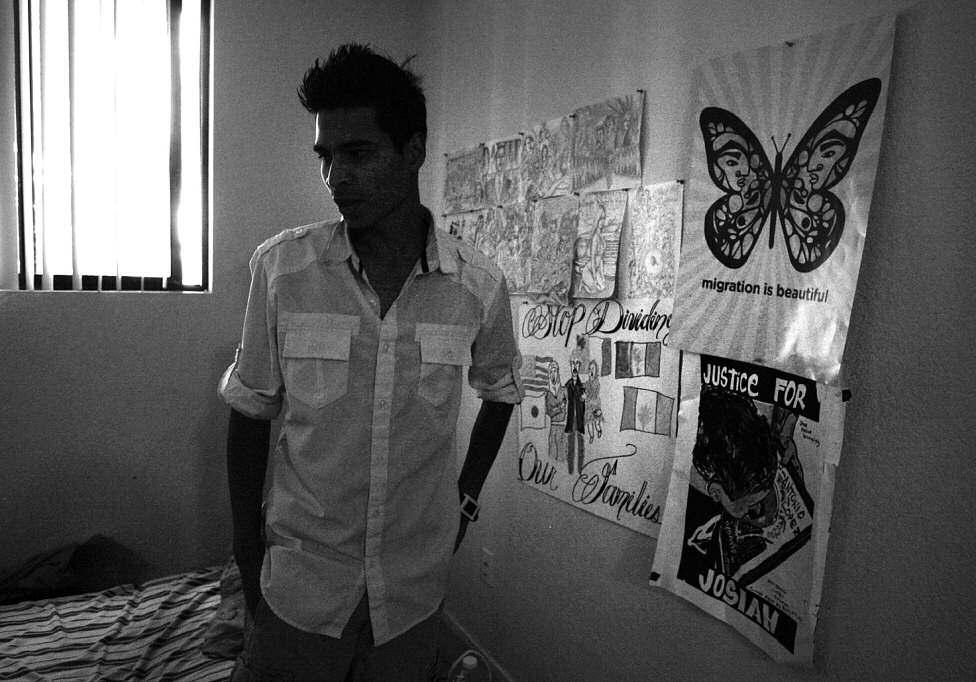
Multiple posters from different campaigns ador n the walls of his room, and David keeps a little allig ator keychain on his bag as a reminder of his mom. Gonzalez recently graduated from Richmond High School and is now a student at San Jose State, an accomplishment he once thought was impossible as an undocumented student. He is striving to make his parents proud. “They were working hard to try to give us a better life. I feel like I could pay them back by doing the best I can in school and succeeding in life,” Gonzalez said.
Gonzalezcontinuesto ghtforhismoth-
er On Sundays, Gonzalez travels to his local
church to collect signatures for his mom. He wants the U S Senate to create a private bill that would allow his mother to return. He says his involvement in immigration rights campaigns is his way of expressing his love for his family, and his strong belief that all human beings deserve the same rights is what drives his passion for change. It’s basically standing up for what I believe is right. I got tired of how my family was separated, and I haven’t seen my mom in three years,” Gonzalez said. “I want to make a difference. I want to give back and speak for those whose voices can’t be heard.”
 BY CARL SIBLEY Mosaic Staff Writer
BY CARL SIBLEY Mosaic Staff Writer
Chudo Loo doesn’t own a bike. Yet he still pedals along the busy bike lanes of downtown San Jose with his wife close behind him.
Loo is one of the 1,800 San Jose membersofBayAreaBikeShare(www.bayareabikeshare.com), a bike rental program that has spread across Silicon Valley and beyond.
The program began last August when the Alta Bicycle Share company chose the Bay Area as one of the regions for its bike share program, a system that has already been implemented in cities such as Washington, Chicago and New York. Currently the bike share program only extendsto veBayAreacities:Redwood City, San Jose, Mountain View, San Francisco and Palo Alto, with 70 stations total. With the recent completion of its 70th
station, Bay Area Bike Share has met its projected goal and prepares to shift into high gear.
“In the near future we will expand the number of bikes by 300 and the number of stations by 30 within the ve existing Bay Area Bike Share cities,” said Ralph Borrmann, a spokesman for the Bay Area Air Quality Management District, which oversees and funds Bay Area Bike Share. “The Metropolitan Transportation Commission has allocated additional funding to expand into the East Bay cities of Berkeley, Emeryville and Oakland as soon as reorganization issues with the bike supplier are worked out.”
The Bay Area Bike Share system can be confusing at rst, since unlike many other bike rental programs, it’s meant for short commutes, not for tourism. Customers use a credit card to gain a temporary or annual membership, which allows them to check out a bike from a rack with the con-
dition that they return it to another rack within 30 minutes. If customers exceed the 30-minute deadline, they must pay an additional fee for every subsequent half hour.
Bike Share was developed to be a last-mile commute which works well with existing transit infrastructure,” Borrmann said.
Loo’s average bike share trip is a route from his home near the Diridon train station to San Jose State, where he and his wife proceed to take a dip in the campus swimming pool. Wearing matching bright yellow T-shirts and navigating in single le,theyusedthebikesforatripdowntown on a recent Monday.
“There’s no need to own a bike, no need for space for one at home, no maintenance,” Loo said.
He mentioned a few ways he thought the program could improve, noting that the bikes were often slightly damaged or coated in sap, so he proposed an awning over the bikes to keep them cleaner. He said he would like more stations along The Alameda, one of the busier streets in San Jose. With the proposed stations, Loo’s wish might come true.
Adults are not required by law to wear helmets while riding, but Bay Area Bike Share advises that customers wear helmets anyway.
The program does not provide helmets with their bikes. Borrmann said a commercial mode of helmet distribution is being tested, and Bay Area Bike Share offers a $10 helmet rebate coupon to all members.
Borrman says the Bay Area is an ideal environment for such a program, thanks to its infrastructure of bike lanes and good year-round weather.
There is a strong pre-existing bike culture,” Borrmann said.
In a new campaign, civic leaders are connecting two of San Francisco’s most visible populations to alleviate the hardships of what they say is a neglected group of LGBTQ and homeless communities.
According to San Francisco’s 2013 PointIn-Time Count, 29 percent of the homeless populationinSanFranciscoidenti edaslesbian, gay, bisexual, or transgender, and city leaders say that number is growing.
San Francisco isn’t the only place where homelessness in the LGBTQ “Q” standing for queer in variations of the description community is gaining attention. Across the Bay Area, young leaders are pushing for more public recognition of this homeless subset.
There’s an astronomical amount of LGBT youth that are homeless,” said AJ, a 21 year-old transgender staff member at the LGBTQ Youth Space in San Jose, who asked not to be fully named out of privacy concerns. “Most resources that are there for people that are homeless are for people that have a healthy family environment or need such things like that. Those aren’t catered speci callytoLGBTQpeople.”
AJ says LGBTQ homeless youth should be given more resources, such as accessible shelters with experienced staff, more accessible mental health services for people who don’t have insurance, and more job
placement especially for transgender youth, whooften ndthemselvesisolatedinthe LGBTQ community.
K ate Calimquim, program manager for the Castro Youth Housing Initiative in San Francisco, says she believes homeless youth will be able to grow into successful young adults by being provided with more education and health services.
“I ndthatthey’reincrediblyresilient,” Calimquim says. “Having a space to stay where their identities are supported, nurtured and cared for, they can blossom to branch out in other goals”
The city of San Francisco is tackling the issue with a plan to reduce LGBTQ homelessnessby50percentwithinthenext ve years.Cityof cialsarealreadyallocating funding and resources, and will collect statistics to measure their progress.
Bevan Dufty, director of the Mayor’s OfceofHousingOpportunity,Partnerships & Engagement in San Francisco, says she was inspired to bring up the issue after conducting a survey last October at the LGBTQ Connect, an event where homeless residents were offered help in the form of dental care, hygiene kits and food packages.
Dufty says 29 percent of the homeless residentswhoreceivedsuppliesidenti edas LGBTQ, adding that represents a huge challenge in the San Francisco community.
HOPE held an LGBTQ Homelessness Policy Forum on June 16 at the LGBTQ Community Center in San Francisco where
panelists and speakers, including electedof cials,community leaders, and LGBTQ community members, argued for more culturally friendly policies and resources for education, nutrition and housing.

Campus shootings prompt gradual shiftsinhow schoolsrespond
BY LUISA SIMPAO Mosaic Staff WriterAn increase in school shootings since the Sandy Hook Elementary School massacre in 2012 has led schools nationwide to implement new response tactics to minimize casualties in the case of a gunman at school.
The shooting at Sandy Hook in Newtown, Conn., was the second deadliest mass shooting by a single person in the United States when Adam Peter Lanza opened retwoweeksbeforeChristmas,killingsix facultymembersand20 rst-graders.
Since the incident, there have been 74 school shootings, compared with 24 reported in the two years before that, raising the urgency of how schools deal with such tragedies.
The newest tactic of “Run, Hide, Defend” was implemented after years of development as schools applied their knowledge to modify school safety policies.
“We hope that it gives people some tools to help them survive the worst scenario anyone could ever face as an unar med civilian,” said Capt. Alan Cavallo of San Jose State University Police. “We hope it gives them some ideas and helps them think ‘what if’ so they have a plan.”
The rstshiftinschoolemergencyresponse came after the April 1999 shooting at Columbine High School in Colorado, which resulted in 15 deaths, including the suicide deaths of the two shooters. That incident proved that the natural instinct to eewasnotenough.
After that, school lockdown procedures were implemented during which teachers were trained to lock classroom doors and keep students quiet and hidden to divert shooters from what they might believe were empty classrooms.
The lockdown procedure was the standard until Sandy Hook, where Lanza entered classrooms and killed two teachers and their students. Because lockdown was not enough, law enforcement and school of cialsrealizedtheyneededtoadvise physical resistance as a last resort.
Elements of “Run, Hide, Defend” have shown some effectiveness. In late May, six UC Santa Barbara students were killed by Elliot Rodger. The shooter’s carnage was reduced as students of the Alpha Phi sorority house refused to open their doors to him.
Other plans to reduce LGBTQ homelessness in the San Francisco area include providing more social services to address substance abuse, sexual health, education, and unemployment.
District 8 Supervisor Scott Wiener, who serves on the Budget & Finance Committee of San Francisco, says he supports strengthening displacement protections in the city to provide more stable living conditions.
“The San Francisco LGBT community is among the most resourceful and effective communities in the world,” Wiener says in a statement. “We have successfully facedsomeofthosemostdif cultchallenges imaginable, whether the continuing HIV epidemic, attacks on our civil rights, or bullying of our young people. Working together, we can successfully face this housing crisis as well.” AJ,
InearlyJune,astudentinSeattlePaci c University opened re at the campus leaving three wounded and one dead; students attacked and held down Aaron Ybarra as he was reloading his gun. More recently, 15-year-old Jared Padgett shot a classmate at Reynolds High School in Portland, Ore., before he met police forces and shot himself in a school bathroom. When shots were rst heard from the boys locker room, the school was immediately locked down.
In addition to their extensive roles in responding to an active shooter on school campuses, police have been involved in trainingbothof cersandschoolof cials. In August 2013, the San Jose Police Depar tment began offering countywide training for schools and youth centers in active shooter response.
“‘Run, Hide, Defend’ gives people something to think about,” said Sgt. Jason Pierce, head of the School Liaison Unit of the San Jose Police Department, noting thatof cials“havetogivethemthetools to defend themselves.”
There are only 15 years left before the environment can no longer sustain life as it is now.
Sudhanshu Jain from Silicon Valley’s Citizens’ Climate Lobby said, “All human life could go extinct if we wait too long; we only have limited time left to make serious changes, we especially need to stop burning fossil fuels.”
Many environmentalists and ordinary citizens are trying to take action regarding climate change. Citizens of San Jose must realize the importance of the issue and take action now.
According to Lisa Altieri, co-founder of 350 Silicon Valley close to the time since we started burning fossil fuels, global average temperature has increased by 1.5 degrees Fahrenheit. An increase in the global average surface temperature has led scientists and policymakers to agree that this war ming is having a negative impact therefore warming must be kept below 3.6 degrees Fahrenheit. This is the amount of change in the temperature, not an actual temperature reading, so a conversion tool is used. Statistics show that we will pass this 3.6 degrees Fahrenheit limit in the next 20 years,
meaning that we will not have an environment to live in. Locals are taking action. The city of Palo Alto voted in 100 percent Carbon Neutral electricity in 2013. Many cities around the Bay Area are considering Community Choice Aggregation contracts, which allow the purchase of renewable electricity directly instead of through PG&E.
Altieri strongly agrees with Jain and said, “We interact with the environment every day with everything and people don’t wake up thinking that they’re going to go hurt the environment, but everyone has an impact in some kind of way.”
Altieri suggests two main ideas for citizens to do. First, people should become aware of the actions they take in their daily lives that impact the environment and think on how they can lower their carbon footprint. That does not mean youhavetogooutandbuyafuel-ef cientcar,butithelps to use a free online carbon calculator and manage personal carbon emissions.
What a lot of people don’t know about is that there is technology that can be used to improve. Instead of burning fossil fuels, people can transition to solar energy. More people are adopting solar energy because it doesn’t produce the harmful pollutants responsible for increasing the green-
house effect that leads to climate change.
The second big thing to do is communicate about the issue. According to Altieri, the government does listen and takes notice and improvement may take longer than wanted, but we have to start somewhere.
Everyone hears about climate change and its impact. However,the ghtisstillnotbeingtakenseriously.
Bay Area resident and environmentalist author Paul Fleischmansays,“Unlikethe ghtforwomen’ssuffrage,civilrights and gay rights, this movement comes with a ticking clock. We can get the word out through photos, videos, conversations, protests and a combination of them all, but the hard part is ndingawaythatactuallychangespeople’sminds.”
People must actively participate in efforts to better the environment. This doesn’t mean they have to partake in protests and rallies, but simple changes in everyday life can make a big difference.
“We must take action and lower our emissions over the next decade. The good news: We have all the technology and solutions to do this. The better news: If we do so, we will create jobs, save money and improve our health,” says Altieri.
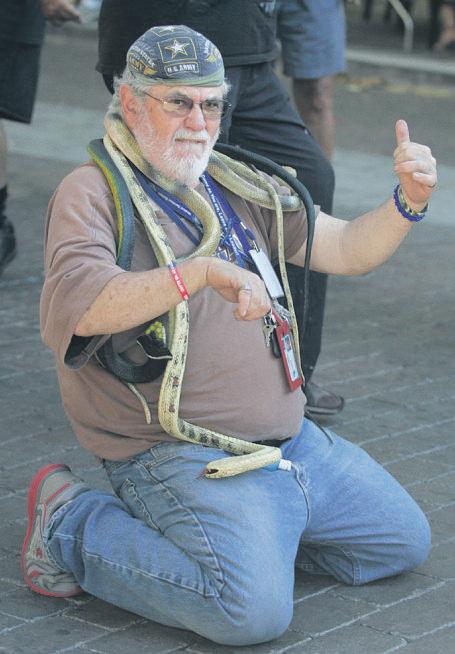
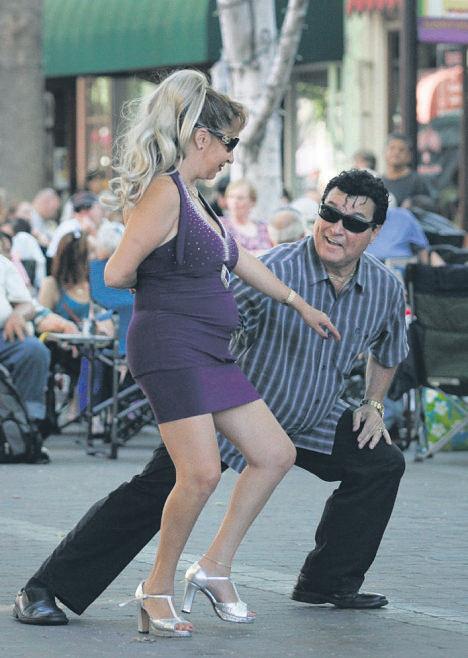
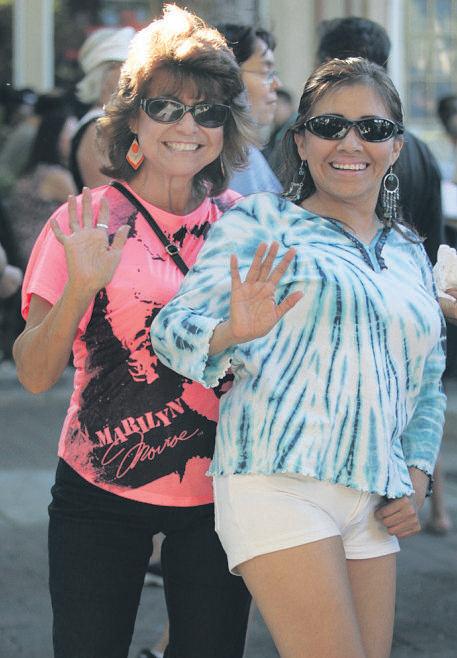
casting, and off-beat directorial choices (likenobalconyinthe“balconyscene” for “Romeo & Juliet”) really put people off.”
He also said that other theater companies in San Jose produced more relevant plays.
Lisa Mallette, executive artistic director of City Lights Theater Company, also said that while relevance may help ticket sales, other factors, like timing and communication, are important.
But the primary question is: “How many hearts did you touch?” she said.
With the closing of the theater, many downtown businesses worry about the economic impact. Eugenie Ooi, an employee at Tengu Sushi across the street from the Rep anticipated losing business, especially at night, from the Rep’s closing.
In addition, the loss of the Rep could harm other theater companies, said Mallette. While some Rep patrons said they would continue supporting San Jose theater productions, individuals not as accustomed with theater might invest elsewhere.
BY HALEY KIM Mosaic Staff Writerthey spun and jumped, and dancers high-kicked, waved their arms and swung their hips.
| FROM PAGE 1
increase their familiarity with electronics spanning from futuristic robots to old desktop PCs. A sophomore at San Jose State, he works as a par t of a new community effort toincreasetechnologicalpro ciency.
“Just giving whatever kind of computers to people is not a solution; it’s only putting a Band-Aid on part of the whole wound,” said Pham. “With so many smartphones out there at such cheap prices, lots of people have electronics. But they’re usually still digitally illiterate.”
At the Third Street Community Center in downtown San Jose, where Pham volunteers, a large number of San Jose students in grade school from lower-income households get help with their schoolwork and learn how to work on desktop computers. Nearly 150 volunteers and four instructors are employed by the center, which is based
POT
| FROM PAGE 1
“This is a de facto ban,” said Sean Donahoe, deputy director of the California Cannabis Industry Association. “We are looking for a workable ordinance to end the gray area. A workable ordinance is not a de facto ban
Suppor ters hope new regulations will improve community and business environments, such as schools and industrial parks.
“These regulations will tighten up rules in regards to marijuana. We understand that people need medicated marijuana, but we would like to discourage recreational usage, eliminating collectives in commercial neighborhoods,” Vice Mayor Madison Nguyen said. “This is going to provide a safe environment for our school children.”
According to a city survey of San Jose residents, many worried that pot shops located near their homes and schools are not safe. The new ordinance sets zoning regulations that will cut down eligible marijuana dispensary locations to less than 1 percent of San Jose’s area.
Pot shops will also have to abide by stricter security regulations: Distribution locations must be fully equipped with security cameras and recording systems at all times; medical marijuana must be locked and stored away in vaults or safes; and the premises must be secured to prevent unauthorized entry.
The ordinance also mandates that dispensaries cannot operate between 9 p.m. and 9 a.m., and those younger than 21 are barred from entering pot shops or buying marijuana products.
In a separate city survey, corporations and technology companies in San Jose voiced concern that marijuana collectives near their businesses drive away potential employees and customers.
“There have been negative impacts on
Businesses in downtown collaborate to produce the 11-concert series and draw people to the area. Besides hearing music, visitors can also browse vendors for food, drinks, KettlePop and more. Antuzzi and Wyrick said that about 1,500 people attend each concert. “It creates a sense of place downtown,” Wyrick said. It is so popular that by 6:30 p.m., he said, South Murphy Avenue is a “nuthouse.”
At the first concert, members of the local cover band the Cheeseballs were decked out in sequins, sunglasses and coordinated cheery red-and-white outfits. With synchronized arm motions and harmonized voices, The Cheeseballs had the audience filling the asphalt dance floor even before the last beats of the first song. Band leader Eric Cotton said outdoor festivals draw a built-in crowd. The hits are already there,” said Cotton, explaining the ease of choosing songs to play. “The older crowd
The festival’s format has changed little in 16 years, said organizers Joe Antuzzi and Joe Wyrick, both of the Sunnyvale Downtown Association. The audience of most y middle-age adults remains largely the same year after year.
in a section of a large church.
Most digital illiterates are kids who str ug gle with English and live in extreme poverty,” said Rosemary Baez, the center’s executive director. “Close to 100 percent of them do not even have basic computer skills. When they come in, they know what to do with the touch screen computers, but are lost with normal computers.”
“Itisessentialtostartprevention(oftech illiteracy) at an early age, when most people are blank slates and are super curious about everything,” she continued.
The Digital Leaders intern program, located 20 minutes northwest of San Jose in Palo Alto also serves students from lower-income families It recently received a $20,000 dollar grant from the Knight Foundation, which aims to connect students with technology to improve their overall academic performance.
businesses near blocks and surrounding blocks where dispensaries are located,” said Jim Reed, Vice President of Public Policy for the San Jose Silicon Valley Chamber of Commerce. “We think the voters and businesseswantrestrictionsto ndamiddle-ground solution on regulating marijuana, and we think the ordinance struck the right balance.”
But Donahoe said problems with dealing pot to minors and unsafe conditions apply to only a few problematic locations, and the ordinance will unfairly force the majority of marijuana businesses to close.
Critics also oppose a new requirement that marijuana sold in San Jose must be g rown either in or next to Santa Clara County. Donahoe said many pot shops sell marijuana products produced elsewhere because they do not have the resources for marijuana manufacturing.
“We want a regulated industry that can provide patients with access to safe and well-regulated products, as well as a variety of them,” Donahoe stated.
Dave Hodges, head of the All American Cannabis Club, is leading his organization in challenging the ordinance. Members have been walking through downtown and distributing free shirts as they collect funds and signatures to form a petition.
“Right now we’re just reaching out to locals or anybody who needs a part-time job. We’re trying to hire 300 people over the next 30 days to help us in this cause,” Hodges said June 20, when club members attended the San Jose Bike Party to recruit new members.
Donahoe and his allies say they will continue to ght to keep their businesses alive
“Whether a ban or a de facto ban, neither of these are a good public policy solution,” Donahoesaid.“Wehaveto ndabetter way, and we will.”
likes the old-school stuff,” like blues, jazz and ’70s’ music he said. Cotton said band members love to play songs that bring the crowd to the dance floor.
“I look forward to it,” said early arriver Gerri Vicente, 58, sitting with a group of friends. She said she has been attending for years, and that she enjoys almost all the bands. It’s a great way to get out of the house and enjoy summer, especially for people over 40, she said. Viki Bird, a longtime Sunnyvale resident, said the best part of the festival is the music and watching people dance. Joe Nazareth, from Goa, India, said he loves music and dancing, and that he can watch people and quickly pick up steps. But music geared to an older crowd attracted few teenagers. One young visitor, who gave her name only as Ariauna, said there were “a lot of old people.” She suggested playing more songs from 2014 to appeal to young adults.
Nevertheless, Ariauna said she liked the concert.
Cotton said that with great food, good music and free admission, “Why wouldn’t you want to come?”
The program was launched in 2011 by the Palo Alto Housing Corp., a group that g over ns affordable housing in that city. The program works directly with Adobe Voices, a part of Adobe Systems that specializesindigital lm-making, to provide internships for students who live in affordable housing and teach them how to produce video on computers.
Ana Angel, coordinator of the program, remembers not having a computer until college, and cited that as one of the mainreasonsshechoseto ght the digital divide in Palo Alto.
The city s school district gives everyone in the school district from poorer backgrounds a MacBook laptop, but then nobody knows what to do
AUDRIE’S LAW | FROM PAGE 1
It’s better for all the theater companies to be doing well than doing poorly, Mallette said. She said that if someone goes to see a City Lights production and enjoys it, it is more likely they will see other shows. While City Lights has stayed in the black for nearly 11 seasons, the company is currently lagging in individual contributions.
The Rep s shutdown also means that 51 employees are out of work, said Mallette. Kahn of San Jose State wrote that many of the alumni worked there over the years, and the department will miss the opportunities, including internships.
Some fans may migrate to companies like the San Jose Stage Company, which will honor Rep patrons’ unused tickets for its production of “Bonnie and Clyde.”
Elizabeth Monley, a 34-year Rep patron, said, “The closing has created a real depression amongst people in their sense of loss in downtown San Jose.”
with them, how to use them,” she said. “We cover the latter, and that makes the whole system work. Each part needs the other.”
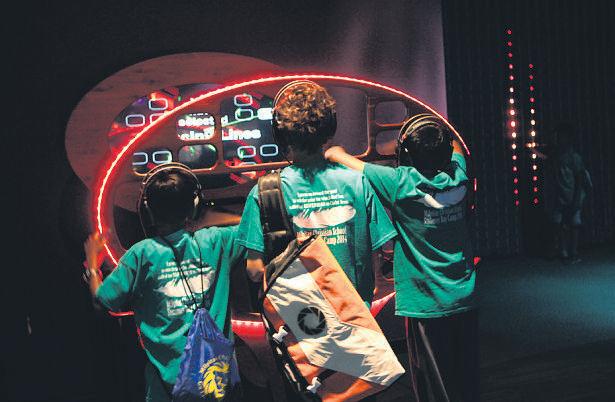
bly Public Safety Committee unanimously passed Senate Bill 838 ‘Audrie’s Law’ out of committee. … Audrie’s Law modernizes the consequences for those who sexually assault intoxicated, incapacitated, and handicapped victims,” Santa Clara County District Attorney Jeff Rosen said in a statement. “The SantaClaraCountyDistrictAttorney’sOf ce stands alongside the Pott Family and State Sen. Jim Beall in their efforts to create positive and reasonable changes from the pain of Audrie’s tragedy.”
Debate remains, however, about whether Audrie’s Law would improve California’s juvenile justice system. Proponents cite needs to repair awsinthesystemandimposeharsher consequences for more serious crimes, while opponents question its effectiveness on juveniles. A main point of contention was the legislation’s original provision of a minimum two-year out-of-home sentence for convictedjuveniles,whichwouldhavebeenthe rst mandatory minimum sentencing in California’s juvenile justice system.
Some students at Saratoga High School said that while the law is imperfect, it would make consequences equal the weight of seriousness for crimes like sexual assault.
Caleb Liu, a former Saratoga High School student, agreed with proponents’ view that the original three offenders’ sentences of 30 to 45 days were light, but said the law probably would not have made much of a difference in Pott s situation.
According to the Santa Clara County Sheriff ’ s Of ce Pott passed out drunk at a party and awoke with messages and drawings on her half-naked body. Three teenage boys admitted to the attack and to circulating cellphone pictures of the incident. Pott hanged herself in her Los Altos home on Sept. 12, 2012. Her mother, Sheila Pott, and Beall introduced Audrie’s Law in March 2014.
Liu said teenagers are unlikely to stay upto-date or be knowledgeable about laws and
criminal consequences.
“I don’t think they [the offenders] would have known of this law. If I didn’t go to my school I probably wouldn’t even know this law existed, he said.
Saratoga High School Principal Paul Robinson and three of the student journalists who covered Audrie’s case declined to comment.
The San Jose Mercury News reported in June that two of the three convicted juveniles in Audrie’s case have re-offended since last year.
“They’re not being rehabilitated” in the current system said Robert Allard, attorney for the Pott family.
Allard added that the proposed law would xhowthejusticesystemtreatsjuvenileoffenders by providing them professional care and training about sexual assault and cyberbullying.
Opponents criticized the minimum sentence as unnecessarily punitive. Attorney Eric Schweitzer, of the California Attorneys for Criminal Justice, conceded that the current juvenile justice system is stretched to its limit, but argued that Audrie’s Law and the extra institutionalization would act as neither a deterrent to juvenile crime nor an effective consequence to convicted offenders. Schweitzer also challenged the idea that Pott was sexually assaulted at the party.
If those crimes were committed, the laws thatforbadethoseillegalactivitiesinthe rst place “clearly didn’t do anything,” he said.
“They’re going to do it whether you pass the law or not,” Schweitzer said. “You can do a lot of good for at-risk children by treating them like children, not like adults.”
Raj Jayadev of the Silicon Valley De-Bug, an organization involved in criminal justice advocacy, said in the face of tragedies like Audrie’s, lawmakers should consider changes that would work in the long run, “rather than the knee-jerk response of minimum sentencing.”